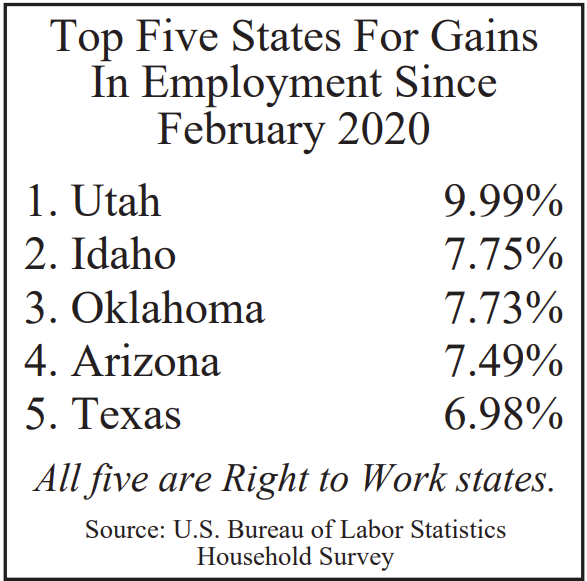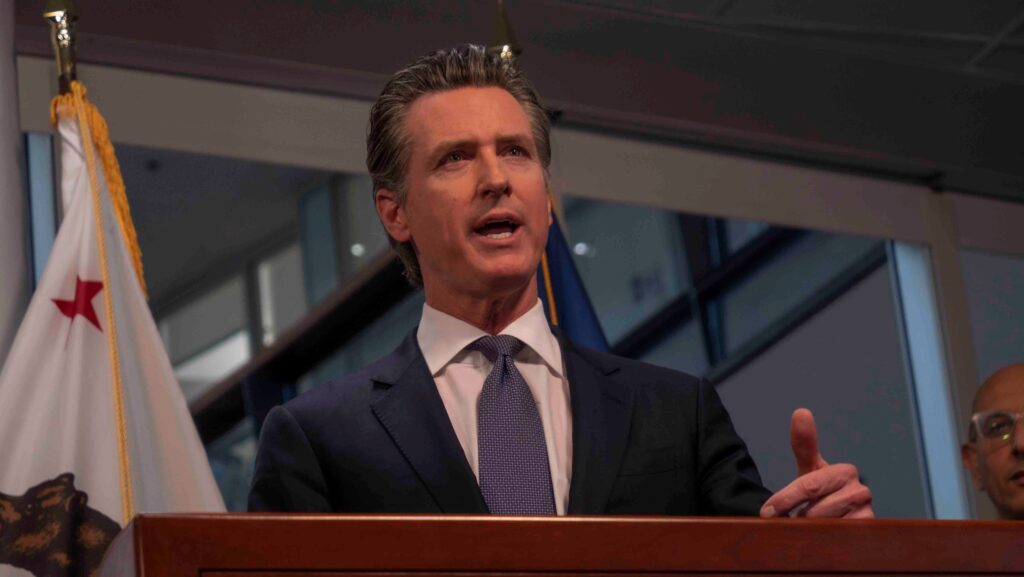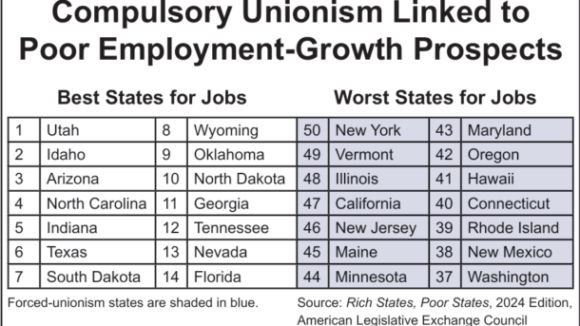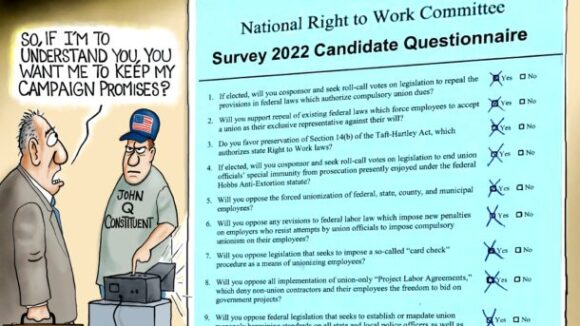Is This Any Way to Run a City’s Schools?
Leaked CTU Proposals Won’t Do Anything to Improve Schools’ Poor Performance

The economic contrast between forced-unionism and Right to Work states has been especially stark over the past four years.
In February 2020, the last month before politicians at all levels of government forced millions of businesses to shut their doors with the aim of slowing the spread of COVID-19, there were 80.0 million people employed in the 23 forced-unionism states and 78.34 million employed in the 27 Right to Work states.
By December 2023, the last month for which the U.S. Labor Department’s Bureau of Labor Statistics (BLS) Household Survey data were available as this Newsletter edition went to press, employment in Right to Work states had risen by nearly 3.1 million since February 2020, reaching 81.44 million.
Meanwhile, the combined employment for forced-dues states last December was 78.93 million, or nearly 1.1 million below its February 2020 level.
National Right to Work Committee President Mark Mix commented:
“Part of the 2020-24 great divide between Right to Work and Big Labor-controlled states with regard to employment growth can be explained by special factors, including most notably union boss-backed politicians’ unaccountable slowness in lifting COVID-19 related restrictions.
“For well over a year, union-label politicians who rule forced-dues states like California and New York kept public schools and retail businesses shut down. Long after medical experts had determined going back to school posed little COVID risk to youngsters, powerful teacher union bosses put the pressure on Big Labor politicians to keep school doors locked. And the extended business closures continuing long after the pandemic had ebbed wreaked enormous economic havoc with minimal, if any, public health benefits.
“Unfortunately, the fact is that employment growth in Big Labor strongholds like California, Illinois and New Jersey has continued to be negative, or abysmally slow, since the COVID-19 business restrictions were belatedly lifted.
“That’s why, from December 2022 to December 2023, even as employment expanded by a healthy 1.44 million in Right to Work states collectively, it fell by roughly 144,000 in forced-unionism states in the aggregate.
“Looking back over the decade from 2012 to 2022, employment in states lacking Right to Work statutes or constitutional amendments for the entire period grew by barely more than half as much as the Right to Work average of 15.7%.”
“No wonder,” continued Mr. Mix, “elected officials who are genuinely committed to expanding employment opportunities are currently fighting to build Capitol Hill support for S.532/H.R.1200, also known as the National Right to Work Act.
“This much-needed reform would spur the growth of employment opportunities nationwide by ensuring employees in all 50 states have the freedom to decide for themselves whether or not a union deserves their financial support.
“It would accomplish this end without adding a single word to federal labor law.
Instead, it would repeal all the current provisions in federal labor law that authorize compulsory union dues.”
As the second session of the 118th Congress began on January 9, 150 senators and House members were already sponsors or cosponsors of S.532/H.R.1200. That’s more than was achieved in the entirety of either of the last two Congresses.
Last November 30, Chairman Bob Good’s (R-Va.) House Subcommittee on Health, Employment, Labor, and Pensions held the first congressional hearing on national Right to Work legislation since 1996, and the first-ever in the House.
But even as Right to Work strength in Congress grows, Democrat President Joe Biden has made it clear, again and again, that his aim is to take federal labor policy in the opposite direction.
During his 2019-20 campaign for the White House, Mr. Biden made his intentions plain in videotaped remarks addressed towards Teamster bosses and militants in Las Vegas:
“We should change the federal law [so] there is no Right to Work allowed anywhere in the country.”
President Biden’s weapon of choice for effectively abolishing state Right to Work laws is S.567/H.R.20, aptly labeled by proponents as the “Richard L. Trumka PRO Act,” in honor of the violent-minded union chief who headed the AFL-CIO from 2009 until he passed away in 2021.
The common aim of this enormous bill’s many provisions is to make herding employees into a forced-dues regime as easy as pushing a button.
And the most damaging “PRO” Act provision of all states that the extraction of forced fees from employees for union monopoly bargaining, regardless of whether it benefits or hurts them personally, shall be “valid” notwithstanding “any State or Territorial law.”
In simple terms, this bill would repeal all state Right to Work laws across the country, even though there is ample and growing evidence such laws foster economic growth by protecting employees’ individual freedom.
While the House rubber-stamped the PRO Act in March 2021 at Big Labor’s behest, union lobbyists were unable that year or the next to ram this power grab through the Senate due to intense public opposition mobilized by National Right to Work and other organizations.
In the 2022 elections, House support for the PRO Act apparently dipped below the 218 votes needed to pass the bill as six 100% pro-Right to Work candidates captured seats that had previously been held by union-label politicians.
But the fate of state Right to Work laws will clearly be up for grabs again in this fall’s elections, with Big Labor operatives’ needing only to pick up a small handful of House seats and hold their ground in Senate races to once again have majority support for the PRO Act in both chambers of Congress.
“Barring a sudden and dramatic change of heart on Joe Biden’s part,” commented Mr. Mix, “if he is still President next year, and Congress sends legislation destroying all state Right to Work laws to his desk, he will sign it.
“The results will be a devastating loss of personal freedom for workers and a shipwreck for the U.S. economy.”



But the Committee is determined, through effective execution of its 2024 federal candidate survey program, to prevent such a scenario from unfolding.
Mr. Mix explained:
“With TV and radio advertising, through the mail and the Internet, and on the phone, Survey 2024 will inform millions of concerned Americans about the pro-forced unionism positions candidates for the U.S. House, the U.S. Senate, and the White House have already taken.
“The Committee will at the same time be mobilizing Right to Work members and supporters to contact their federal candidates, including President Biden and former President Donald Trump, and urge them to oppose monopoly bargaining and forced unionism in the future.
“Big Labor politicians will be left with a choice: repudiate their records of support for union special privileges, or face the potential political consequences.
“Grassroots communications with elected officials who have expressed their support for employees’ Right to Work in the past, such as Mr. Trump, are another critical component of the survey program.
“This year, even many candidates who have pledged 100% support for Right to Work in their responses to their Committee candidate surveys in the past are being inundated with bad advice from Beltway political insiders who falsely assure them that selling out foes of forced unionism is politically smart. [See pp. 4-5 of this Newsletter edition for additional information – Ed.]
“That’s why it’s now more important than ever before for freedom-loving grassroots activists to contact candidates who pledged to support Right to Work in their previous campaigns in order to encourage them to reaffirm their commitment and back it up with effective actions.”
This article was originally published in our monthly newsletter. Go here to access previous newsletter posts.
To support our cause and help end forced unionism, go here to donate.

Leaked CTU Proposals Won’t Do Anything to Improve Schools’ Poor Performance

Wherever Big Labor wields the power to collect forced union dues, union bosses funnel a large share of the confiscated money into efforts to elect and reelect business-bashing politicians. Employment growth tends to lag as a consequence.

Members Insist They Keep Pro-Right to Work Campaign Promises